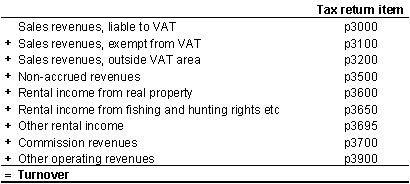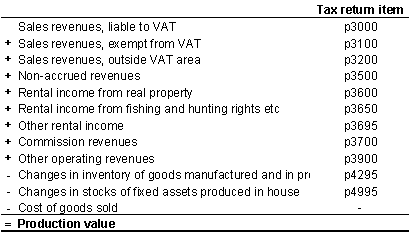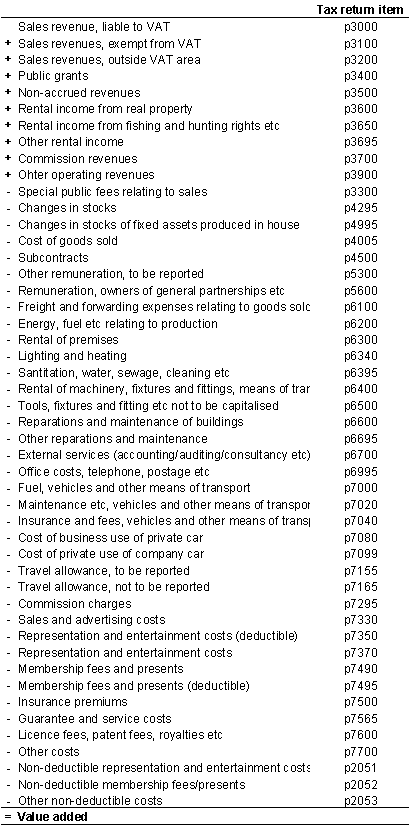Content
About the statistics
Definitions
-
Name and topic
-
Name: Business activities, structural business statistics
Topic: Wholesale and retail trade and service activities
-
Responsible division
-
Division for Structural Business Statistics
-
Definitions of the main concepts and variables
-
Enterprise
In the Standard Industrial Classification (SIC) an enterprise is the smallest combination of legal entities that is an organizational unit producing goods or services, which benefits from a certain degree of autonomy in decision making.
Local kind-of-activity unit (local KAU)
The SIC defines a local KAU as a functional unit, which at a single physical location is engaged primarily in activities within a specific activity group.
Owners
Owners include owners of sole proprietorships, or general partnerships, and family members who work for the enterprise on a daily basis without receiving regular wages. Co-owners of limited companies and cooperatives who are paid for working for the enterprise are not included, nor are family members of owners of sole proprietorships or general partnerships when they receive regular wages.
Employees
The number of employees is collected through the Register of Employees and Employers (the Aa-register). An employee is a person that works for an employer and receive compensation in the form of wages, pay, fee, bonuses, payment in kind etc. There are conditions that the work should last for at least six days and that the employee must be employed on average four or more hours a week for the employee to be notifiable to the Aa-register.
Employment
Employment is the sum of owners and employees. Compared to the Registerbased Employment Statistics http://www.ssb.no/regsys_en/ where persons are counted only in the main industry where they are employed, the structural statistics allows persons with more than one job to be counted as employee in several industries at the same time. The statistics on employment will therefore not be directly comparable.
Employment figures in the structural statistics show an average number during the year.
Temporary staff from employment agencies are not included in the employment figures.
Turnover/sales
Turnover is defined as the sum of remuneration for rendering of services to customers and sales of merchandise, and gross income from other activities. Rental income, commissions and special taxes are included, while subsidies and profits from sales of business assets are not. VAT is not included in the statistics.
Merchandise
Merchandise is goods bought and resold with no added value.Compensation of employees
Compensation of employees includes wages, holiday pay, fees, etc., employer's national insurance contribution, reportable pension costs and other personnel costs. Compensation of employees does not include remuneration to owners of sole proprietorships or partnerships or to family members without regular wages.Production value
Production value means sales corrected for changes in stocks of finished goods, work in progress, and goods and services purchased for resale. Purchases of goods and services for resale are deducted, while capitalized own investment work is added.
Value added
Value added is figured as the sum of production value less the purchase of goods and services (for other goods and services than those purchased for resale) and special public taxes, and corrected for changes in stocks of raw materials and consumer goods. Special public subsidies for manufactured/sold merchandise and other public subsidies/reimbursements are included.
Gross investments
Gross investments are the total value of new capital goods such as buildings and plant, machinery, tools, implements, software, vehicles (except for personal use), both new and used. Improvements are added while sales of used capital stock are deducted. Investment figures are minus incoming value added tax.Acquisitions
This includes investments in new assets and improvements of own assets.New investments include all newly acquired fixed assets acquired and completed in the course of the year, excluding investments in unimproved property. In assessing the value of the business asset, cost price is used for purchases and production cost for own manufactures. Acquisitions through financial leasing are included when the asset is entered as an asset in the balance sheet.
Improvement of own assets includes the value of all capitalized improvements and major repairs purchased and executed by others and/or undertaken by own employees on own business assets. A precondition is that such improvements increase the efficiency/value of and/or prolong the lifetime of the business asset. The improvement is estimated at purchase price at time of purchase or at production cost when it is manufactured.
Sale of business assets
Sale of business assets is estimated at the sales value (replacement value) upon realization of used business assets over the course of the year. The amount includes investment tax. The business asset is regarded as sold when it is delivered.
-
Standard classifications
-
The Standard Industrial Classification (SN2007) used in Statistics Norway is based on the EU's NACE-standard.
The statistics is now published as Business statistics.
